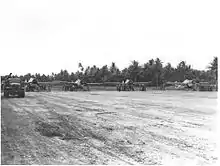Nanumea Airfield.svg.png.webp) | |
|---|---|
| Part of Seventh Air Force | |
| Nanumea, Tuvalu | |
 | |
| Coordinates | 05°41′00″S 176°07′44.4″E / 5.68333°S 176.129000°E |
| Type | Military Airfield |
| Site information | |
| Controlled by | United States Army Air Forces United States Marine Corps |
| Condition | abandoned |
| Site history | |
| Built | 1943 |
| Built by | Seebees |
| In use | 1943-5 |
| Materials | Coral |
Nanumea Airfield is a former World War II airfield on the island of Nanumea in the Ellice Islands (now known as Tuvalu).
History
World War II
Nanumea Airfield was built by United States Navy Seabees during the Pacific War as an alternative strip to Nukufetau and Funafuti airfields, in order to allow for further dispersal of aircraft in the Ellice Islands (now Tuvalu).
On 5 September 1943, elements of the 16th Naval Construction Battalion arrived on Nanumea and on 11 September, they started work on a 7,000 feet (2,100 m) by 200 feet (61 m) bomber landing strip. On 7 September 1943, ten Betty bombers of the 755th Kōkūtai from Tarawa Atoll dropped 20 bombs on Nanumea.
On September 19th, F4F-4s of VMF-441 landed on the strip and continued to use the runway for the remainder of the construction period. The first bombers landed on November 12th. The Seabees also built a camp and operation facilities for the airfield, including an 8,000-barrel tank farm for aviation gasoline.[1][2]
United States Army Air Forces (USAAF) units based at Nanumea included:[3]
- 30th Bombardment Group headquarters from 11 November 1943 – 4 January 1944;
- 27th Bombardment Squadron operating B-24s from 10 November 1943 – 26 February 1944;
- 28th Bombardment Squadron operating B-24s from 12 November 1943 – 13 March 1944;
- 45th Fighter Squadron operating P-40Ns from 28 November 1943 – 4 January 1944.
United States Marine Corps (USMC) units based at Nanumea included:
- Marine Fighting Squadron 441 (VMF-441), flying the F4F Wildcat, operated from Nanumea from September to December 1943.[4][5]
- Marine Attack Squadron 331 (VMA-331) flew Douglas SBD Dauntless dive bombers from Nanumea, starting on 15 November 1943.[4][6]
By September 1944, base roll-up and salvage operations had commenced and were completed by the end of March 1945.[1] Wreckage of the aircraft remained on the island.[7]

Postwar
After the Pacific War, the airfield was dismantled and the land returned to its owners, however as the coral base was compacted to make the runway, the land now provides poor ground for growing coconuts.[8] The airfield will be reopened for domestic service by Air Tuvalu from Funafuti International Airport, beginning in October 2023.[9]
See also
References
- 1 2 Building the Navy's Bases in World War II History of the Bureau of Yards and Docks and the Civil Engineer Corps 1940–1946. US Government Printing Office. 1947. p. 236.
 This article incorporates text from this source, which is in the public domain.
This article incorporates text from this source, which is in the public domain. - ↑ McKillop, Jack. "Ellice Islands". Funafuti, Naval Advance Base. Retrieved 8 June 2015.
- ↑ Maurer, Maxwell AFB (1983). Air Force Combat Units of World War II. Alabama: Office of Air Force History. ISBN 0-89201-092-4.
 This article incorporates text from this source, which is in the public domain.
This article incorporates text from this source, which is in the public domain. - 1 2 Sherrod, Robert (1952). History of Marine Corps Aviation in World War II. Washington, D.C.: Combat Forces Press. OCLC 1261876.
- ↑ Crowder, Michael J. (2000). United States Marine Corps Aviation Squadron Lineage, Insignia & History – Volume One – The Fighter Squadrons. Paducah, KY: Turner Publishing Company. ISBN 1-56311-926-9.
- ↑ "Marine Corps in WWII Vol IV – Western Pacific Operations" (PDF). Marine Aviation Western Pacific. Retrieved 8 June 2015.
 This article incorporates text from this source, which is in the public domain.
This article incorporates text from this source, which is in the public domain. - ↑ Bartsch, Bill. "War Relics in Tuvalu and Kiribati" (PDF). South Pacific Bulletin (1975). Retrieved 7 April 2014.
- ↑ Melei Telavi (1983). "Chapter 18 – War". In Hugh Laracy (ed.). Tuvalu: A History. Institute of Pacific Studies, University of the South Pacific and Government of Tuvalu. p. 143.
- ↑ "Air Tuvalu aircraft arrives". Radio New Zealand (RNZ). 11 October 2023. Retrieved 2 November 2023.
 This article incorporates public domain material from the United States Air Force
This article incorporates public domain material from the United States Air Force This article incorporates public domain material from websites or documents of the United States Marine Corps.
This article incorporates public domain material from websites or documents of the United States Marine Corps.